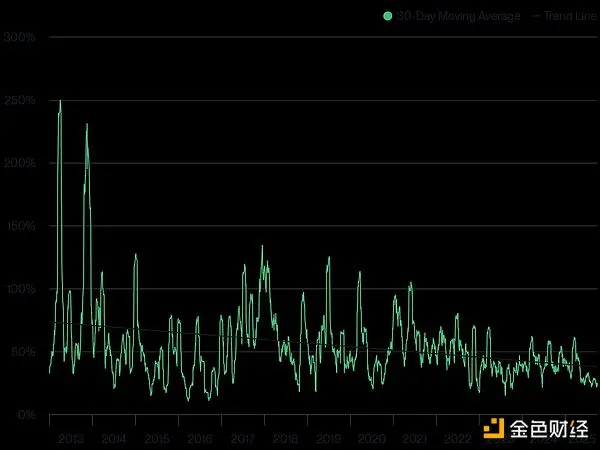Original author: Matt Hougan, Chief Investment Officer, Bitwise
Original article translated by: Jinse Finance
Bitcoin's sideways consolidation suggests its IPO is imminent—which is why BTC allocation is expected to increase.
Jordi Visser is one of my most admired macroeconomic thinkers, and I read every article of his.
His latest article explores a core question: despite a constant stream of positive news—strong ETF inflows, breakthroughs in regulation, and continued growth in institutional demand—why is Bitcoin still frustratingly stuck in sideways or even downward trading?
This is the best analysis I've read in the past six months about the current state of the Bitcoin market, and I highly recommend you read it.
Visser believes that Bitcoin is undergoing a "silent IPO," transforming from a crazy idea into a mainstream success story. He points out that typically, when a stock completes its IPO, it tends to consolidate for 6 to 18 months before initiating an upward trend.
Take Facebook as an example. It went public on May 12, 2012, at $38 per share. For more than a year afterward, its stock price remained flat or even declined, until it finally regained its IPO price of $38 15 months later. Google and other high-profile tech startups have shown similar trends.
Visser stated that sideways trading doesn't necessarily indicate a problem with the stock itself. This situation often arises because founders and early employees cash out and exit—those who bet on the high-risk startup have now reaped hundreds of times their initial investment and naturally want to cash out. The process of insider selling and institutional buying takes time; only after this transfer of ownership reaches a certain equilibrium can the stock price resume its upward trend.
Visser points out that this is remarkably similar to Bitcoin today. Early believers who bought Bitcoin when it was priced at $1, $10, $100, or even $1,000 now possess epoch-making wealth. With Bitcoin entering the mainstream—ETFs listed on the NYSE, large corporations establishing Bitcoin reserves, and sovereign wealth funds entering the market—these investors can finally cash in their profits.
Kudos to them! Their patience has paid off handsomely. Five years ago, if someone had dumped $1 billion worth of Bitcoin, it would likely have thrown the market into chaos; but today, a diverse buyer base and ample trading volume have allowed such large transactions to be absorbed much more smoothly.
It should be noted that the on-chain data shows that the composition of sellers is quite complex. Therefore, Visser's analysis is only one part of the current market drivers, but it is a crucial part and it is worth considering its significance for the future market.
Here are the two core points I extracted from this article:
Viewpoint 1: High potential for further gains
Many cryptocurrency investors were frustrated after reading Visser's article: "Early OGs are dumping Bitcoin on institutions! Do they know something we don't?"
This interpretation is completely wrong.
Early investors selling off their holdings does not signify the end of an asset's journey, but rather the beginning of a new phase.
Consider Facebook as an example: Admittedly, its stock price remained below $38 for a year after its IPO, but it has now risen to $637, a staggering increase of 1576%. Back in 2012, if I could have bought all of Facebook stock at $38, I certainly wouldn't have hesitated.
Of course, investing in Facebook's Series A funding round could have yielded a higher return, but it would have also carried much greater risks.
The same applies to Bitcoin today. In the future, we may find it difficult to see Bitcoin achieve a 100x return within a year again, but once this "transfer of tokens" phase is complete, its upside potential remains enormous. As Bitwise pointed out in its "Bitcoin Long-Term Capital Market Assumptions" report, we believe Bitcoin will reach $1.3 million per coin by 2035, but I personally think this prediction is still conservative.
I'd like to add one more point: there's a key difference between Bitcoin after the early OGs have sold off their holdings and a company after its IPO—a company needs to continue growing after its IPO. Facebook couldn't jump from $38 to $637 overnight because its revenue and profits weren't enough to support such a valuation. It needed to expand revenue, develop new business lines, and focus on mobile, all of which involved inherent risks.
But this isn't the case with Bitcoin. Once the early OGs have finished their sell-off, Bitcoin doesn't need to do anything more. For it to grow from a $2.5 trillion market cap to a gold-level $25 trillion cap, all it needs is widespread acceptance.
I'm not saying this will happen overnight, but it could very well grow faster than Facebook.
From a long-term perspective, Bitcoin's consolidation is a "gift"—an excellent opportunity to buy more before it resumes its upward trend.
Viewpoint 2: The era of allocating 1% of Bitcoin to any one company is over.
As Visser argues in his article, companies that have completed an IPO are far less risky than startups. They have broader equity distributions, face stricter regulations, and have more opportunities for business diversification. Investing in Facebook after its IPO is far less risky than funding a college dropout working in a party house in Palo Alto.
The same applies to Bitcoin. As Bitcoin has transitioned from early adopters to institutional investors and matured as a technology, it no longer faces the existential risks it did a decade ago, and its maturity as an asset class has significantly increased. This is clearly reflected in Bitcoin's volatility—since the Bitcoin ETF began trading in January 2024, its volatility has decreased dramatically.
Bitcoin historical volatility

Data source: Bitwise Asset Management, data period: January 1, 2013 to September 30, 2025
This offers investors an important insight: while Bitcoin's returns may be slightly lower than in the future, volatility will decrease significantly. As an asset allocator, my response to this change is not to sell—after all, we predict that Bitcoin will remain one of the best-performing asset classes globally over the next decade—but rather to increase holdings.
In other words, lower volatility means that holding more of these assets is safer.
Visser's article further convinced me of a trend—over the past few months, Bitwise has held hundreds of meetings with advisors, institutions, and other professional investors, and we've found that the era of allocating 1% of Bitcoin to a portfolio is completely over. More and more investors are starting with 5% as their BTC allocation.
Bitcoin is experiencing its IPO moment. If history is any guide, we should embrace this new phase by increasing our holdings.







